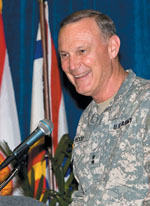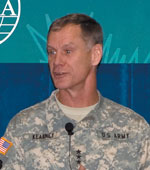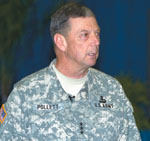Battle Leaders Express Their Frustrations and Needs
 |
| Members of the command, control, communications and computer systems panel (from left) Group Captain Ian Vellely, RAF, deputy director, Intelligence Division (J-2), U.S. Central Command (CENTCOM); Lt. Col. Samuel Anderson, USA, battalion commander, 112th Signal Battalion; and Lt. Col. Russ Smith, USAF, deputy commander, Joint Communications Support Element, listen to panel moderator Brig. Gen. Mark Bowman, USA, director, Command, Control, Communications and Computer Systems (J-6), CENTCOM. |
The military is aggressively seeking help from industry to satisfy its technical requirements, and the need for private-sector support will grow as supplemental funds dry up and budgets are reduced. The U.S. Defense Department, its partners and allies especially are seeking technologies that will break down barriers to information sharing as well as products that eliminate networks and hardware, particularly boxes and wires.
Leaders from across the military community convened to outline their needs and to appeal to industry members for assistance during TechNet Tampa 2009, held at the beginning of March. Brig. Gen. Mark Bowman,
Gen. Bowman also commented on the great need CENTCOM has for bandwidth. The bandwidth allocated to the command is less than 4 percent of the amount used by U.S. Pacific Command and less than 2 percent of U.S. European Command’s bandwidth, yet CENTCOM has two wars in its area of responsibility. The general highlighted the problem with an incident in which four unmanned aerial vehicles were tracking a high-value target. The aircraft lost connectivity for 13 seconds, and the target disappeared for nine months.
He also emphasized the need for solutions to current problems, stating, “We’re interested in today and supporting the warfighters today.” The CENTCOM line of operation that needs the most attention is coalition and information sharing. “That’s where we’re the worst,” Gen. Bowman said. Personnel are working toward a mission network for
Spectrum is another critical need, and managing it correctly is imperative. “It’s the toughest job we have out there,” the general stated, adding, “It’s the underpinning of making everything else work.”
Gen. Bowman touted a few solutions, including thin client and Netted Iridium, both currently in use. He also stressed the need for the One Box, One Wire, or OB1, solution that would enable four networks to operate in one box. At the end of his presentation, he urged listeners to come up with the capabilities warfighters really need. “Do what’s right,” he said. “You have to live with you the rest of your life.”
Also addressing CENTCOM needs at the conference was keynote speaker Maj. Gen. Jay Hood,
The general stated that one of his command’s needs is to increase the ability of ground troops, especially small units, to communicate on the move and over the horizon. He also spoke about several of the solutions mentioned by Gen. Bowman. For example, one way operators are handling the issue of improving ground troop communication is through Netted Iridium. “The Iridium network is now being leveraged [for] push-to-talk radios,” Gen. Hood said. He also echoed Gen. Bowman by touting as a positive development the OB1, which will allow users to monitor multiple systems at once.
 |
| Maj. Gen. David Scott (far left), deputy director, Center for Special Operations, SOCOM, gives a presentation during the intelligence panel. Also on the panel are (from left) Brig. Gen. Brian Keller, USA, military executive, National Geospatial-Intelligence Agency; Maj. Gen. John DeFreitas III, USA, deputy director for analysis and production, Signals Intelligence Directorate, National Security Agency; and panel moderator Konrad Trautman, director of intelligence (J-2), SOCOM. |
The general mentioned an upcoming solution to some problems called the Theater Network Management Architecture, a CENTCOM effort to improve situational awareness across the command’s networks. Gen. Hood said the architecture is critical for operational awareness and will enable personnel to see network events in real time rather than reacting to symptoms and fallout.
According to Lt. Col. Samuel Anderson, USA, battalion commander, 112th Signal Battalion, Gen. Bowman’s companion on the communications panel, many communications barriers already have been overcome. However, he related that several still exist for special operations forces (SOF). It is a myth, according to Col. Anderson, that SOF have no need to communicate with general purpose forces. Because SOF conduct missions in other forces’ battlespace, if they cannot talk to those troops, they cannot operate, he emphasized. Col. Anderson shared that many barriers could be broken from the bottom up. He also said that because troops on the ground have to have certain functions and abilities, why not push capabilities as far forward as possible to solve problems?
 |
| Maj. Gen. Jay Hood, USA, chief of staff, CENTCOM, interacts with the audience during his keynote address. Gen. Hood emphasized the importance of communications to all his command’s work, and he said that infrastructure in and to battle areas need improvement. |
Col. Anderson spoke about knowledge management as well, which he noted is not a function of the command, control, communications and computer systems community but is an area where the community has a role to play. He told about a commander who wanted a portal page resembling NFL.com. The commander used the Web site for his Fantasy Football team and was able to obtain the statistics, strengths, weaknesses and other information about his players. Col. Anderson said that he does not see a strategy to move from where forces are today to an NFL.com for killing bad guys.
Group Captain Ian Vellely, RAF, deputy director of intelligence (J-2), CENTCOM, provided a coalition viewpoint on the panel and echoed Col. Anderson by saying that partners have come a long way to breaking down barriers. He also remarked that many remaining barriers are being worked on. Group Captain Vellely said that the creation and use of the Joint Tactical Information Distribution System (JTIDS) led to new tactics, techniques and procedures; however, not all partners were on the network, and the political reality is that coalitions have difficulty sharing all the time. Building on that idea, he stated that governments will look to fund their own industrial base with research and development funds, which is good, but that also can lead to spoke systems. The aspiration of sharing within a huge coalition is difficult especially because of security concerns.
The group captain added that partners cannot compromise sensitive information. To mitigate potential risks as the coalition moves closer to sharing networks, developers and users need to remain humble and realize they might not always come up with the right answers. People have to think about how to keep operating when networks fail, he shared.
 |
| Lt. Gen. Frank Kearney III, USA, deputy commander, U.S. Special Operations Command (SOCOM), speaks during TechNet Tampa 2009, sharing his frustrations about communications with the crowd. |
Gen. Kearney’s second frustration is the need for command and control from anywhere. The general stated that chief executive officers can communicate and lead from any place, so military commanders should be able to do the same. During his elaboration of this complaint, he mentioned the problem of having so many systems and networks and the hardware necessary to operate them. “How much money in DOD [Defense Department] are we spending on computers and screens?” he asked.
The third item on the general’s frustration list is the lack of a global sensor network. He wants to see the creation of one global network that moves all the data available. It would have redundant communications and a single workstation.
Fourth, the general bemoaned the problems with infrastructure in the CENTCOM area of responsibility. He especially appealed to industry, telling them they know what technologies work in countries in the region and can pass that expertise on to the military. “I’ll buy that data from you so I know what works,” he stated.
Gen. Kearney’s fifth frustration is with Web 2.0. He wants the military to take better advantage of the new tools to recruit and to tell the world about success. He said security and old-fashioned mindsets are barriers to using Web 2.0 completely. “We’re on the edge of change, but you [industry] have to help us,” he said. The general continued to express what he wanted from industry, noting that the military and its partners need industry knowledge. He acknowledged that acquisition is hard, and information assurance needs make processes more difficult. He urged industry members to demand to talk to operators who are relevant to what is being developed and who will use the technology. Gen. Kearney also said people need to stop writing requirements that are impossible to fulfill.
The intelligence panel addressed many of the same themes as some of the other speakers but it did so from the intelligence perspective. Gen. Kearney’s command colleague, moderator Konrad Trautman, director of intelligence (J-2), SOCOM, and panelist Maj. Gen. John DeFreitas III,
Operators, intelligence personnel and planners need to create a more integrated process for information sharing, agreed Maj. Gen. David Scott, USAF, deputy director, Center for Special Operations, SOCOM. Gen. Scott also commented on the need for data mining tools and talked about how data is coming in from new and surprising places. For example, a
Brig. Gen. Brian Keller,
 |
| Lt. Gen. Carroll Pollett, USA, director, Defense Information Systems Agency, delivers a luncheon address. Gen. Pollett says his agency has a no-fail mission as he focuses his efforts on the warfighter. |
The general said he is focused on the warfighter. To make sure his organizations are developing and delivering the right capabilities, he has gone through every program at DISA, and each week he sits down with different GS-15s and colonels in DISA so they can teach him, train him and tell him where they need help. With this knowledge, Gen. Pollett can ask for changes in programs when necessary or work good capabilities into operations.
The general said there is a culture change and new normal for operations. “We’ve got to change the way we’re operating if we’re really going to protect the enterprise,” he said. He noted that there is a change to focus on the warfighter taking responsibility for the network. Also new is the movement toward machine-to-machine capabilities for the first time.
For additional coverage of TechNet Tampa, visit SIGNAL Scape.
Web Resources
SIGNAL Scape: www.afcea.org/signal/signalscape
TechNet Tampa 2009: www.afcea.org/events/tampa/09/Introduction.asp




Comments